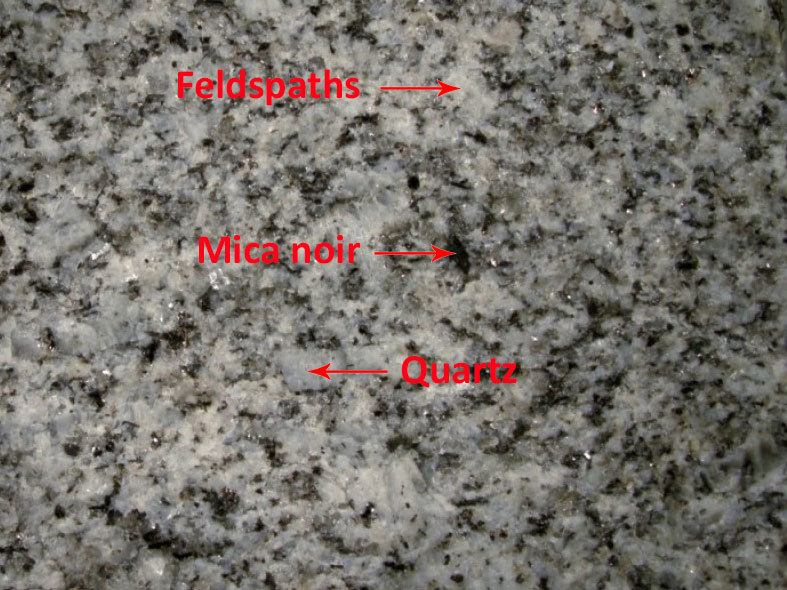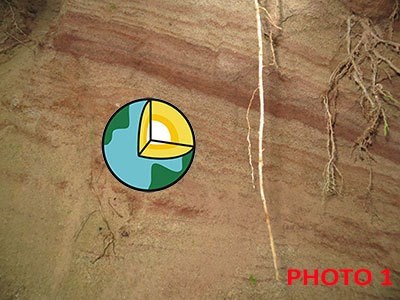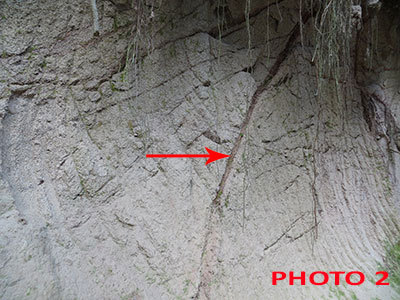Du granite au sable EarthCache
-
Difficulty:
-

-
Terrain:
-

Size:  (other)
(other)
Please note Use of geocaching.com services is subject to the terms and conditions
in our disclaimer.
Du granite au sable
Le granite, assez commun en France, est une roche dure et résistante. C’est ce qui explique son usage en tant que matériau de construction ainsi que dans la réalisation de pavés, bordures de trottoirs, pierres tombale, etc ...
Pourtant cette roche n'est pas indestructible, elle peux s'altérer suite aux conditions extérieures.
Composition du granite:
Le granite est composé de quartz (c'est de la silice), des micas noir (riche en magnésium, en potassium et en fer) ou blanc (riche en aluminium et en potassium), des feldspaths et d'autres minéraux (magnétite, apatite, grenats, etc ...).

Altération du granite:
Les principaux agents d’altération sont :
- l’eau : elle agit de deux façons. D'abord par hydratation (addition d’eau à un élément sans modification chimique de celui-ci). Chez les micas par exemple, l'eau peut se glisser entre les feuillets du minéral, provoquer son gonflement, ce qui va peu à peu désolidariser les grains de la roche. L'eau agit aussi par hydrolyse (décomposition d’une substance sous l’action de l’eau).
- les végétaux qui ont pu s’implanter à la surface du massif (action des racines dans les diaclases et action des molécules organiques issues de la décomposition de ces végétaux).
L'altération se fait différemment selon les éléments présent dans le granite:
Pour le mica noir qui possède du fer dans sa composition, il va se transformer assez rapidement en hydroxyde de fer et en argile.
Pour le mica blanc, il s'altère peu, il va se fragmenter en petites paillettes de même composition chimique.
Pour le quartz, il est inaltérable, une fois séparé des autres éléments il fournit l'essentiel du sable. Pour les feldspaths, par hydrolyse, ils vont se transformer en argile.
Loguez cette cache "Found it" et envoyez-moi vos propositions de réponses soit via mon profil, soit via la messagerie geocaching.com (Message Center), et je vous contacterai en cas de problème.
Questions:
Q1: Aux coordonnées de la earthcache vous pourrez voir la Photo 1, qu'est ce qui est caché derrière le logo earthcache ?
Q2 : Au même endroit frotter légèrement le bas du talus, que pouvez vous observer ?
Q3 : Sur la photo 2, qu'est ce qui est marqué par la flèche ? et d'après le descriptif et vos observations est ce que cet élément participe à l'altération du granit ? .


ENGLISH
From granite to sand
Granite, quite common in France, is a hard and resistant rock. This explains its use as a building material as well as in the construction of pavers, curbs, tombstones, etc ...
Yet this rock is not indestructible, it can be altered due to external conditions.
Composition of the granite:
The granite is composed of quartz (it is silica), black micas (rich in magnesium, potassium and iron) or white (rich in aluminum and potassium), feldspars and other minerals (magnetite, apatite, garnets, etc.).

Alteration of granite:
The main alteration agents are:
- water: it acts in two ways. First by hydration (addition of water to an element without chemical modification thereof). In micas, for example, water can slip between the leaves of the mineral, causing it to swell, which will gradually disconnect the grains from the rock. Water also acts by hydrolysis (decomposition of a substance under the action of water).
- the plants that have been able to settle on the surface of the massif (root action in the diaclases and action of the organic molecules resulting from the decomposition of these plants).
The alteration is done differently according to the elements present in the granite:
For black mica which possesses iron in its composition, it will be transformed rather rapidly into iron hydroxide and into clay.
For white mica, it is not altered very much, it will fragment into small flakes of the same chemical composition.
For quartz, it is unalterable, once separated from the other elements it provides most of the sand.
For feldspars, by hydrolysis, they will transform into clay.
Log in this "Found it" cache and send me your suggestions for answers either via my profile or via messaging geocaching.com (Message Center), and I will contact you if there is a problem.
Questions:
Q1: At the coordinates of the earthcache you will see Photo 1, what is hidden behind the logo earthcache?
Q2 : At the same place rubbing slightly down the slope, what can you observe?
Q3 : In picture 2, what is marked by the arrow? and according to the description and your observations is what this element participates in the alteration of the granite?


Additional Hints
(No hints available.)